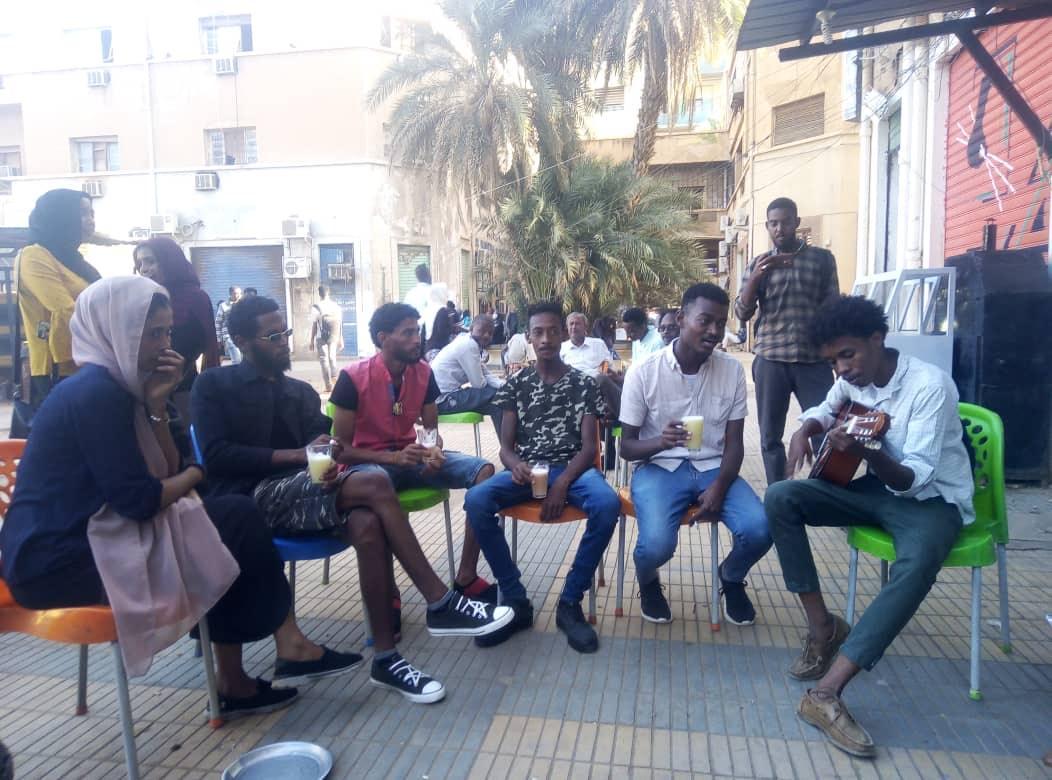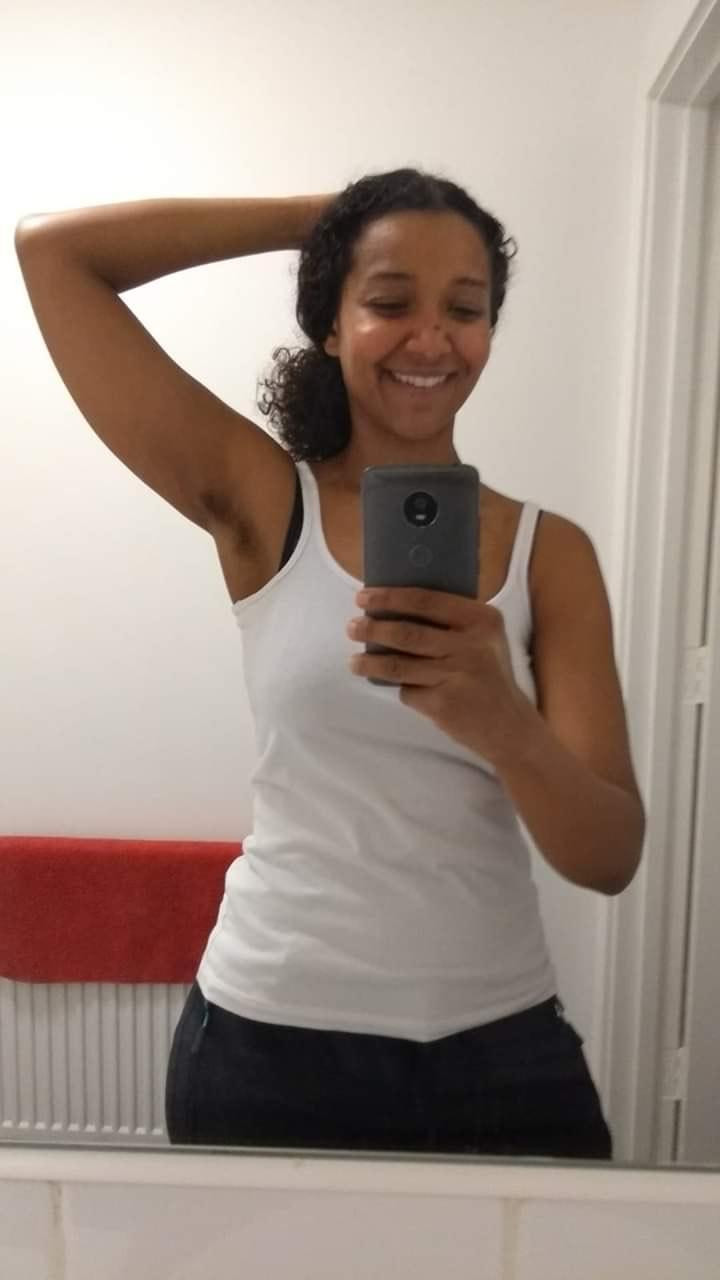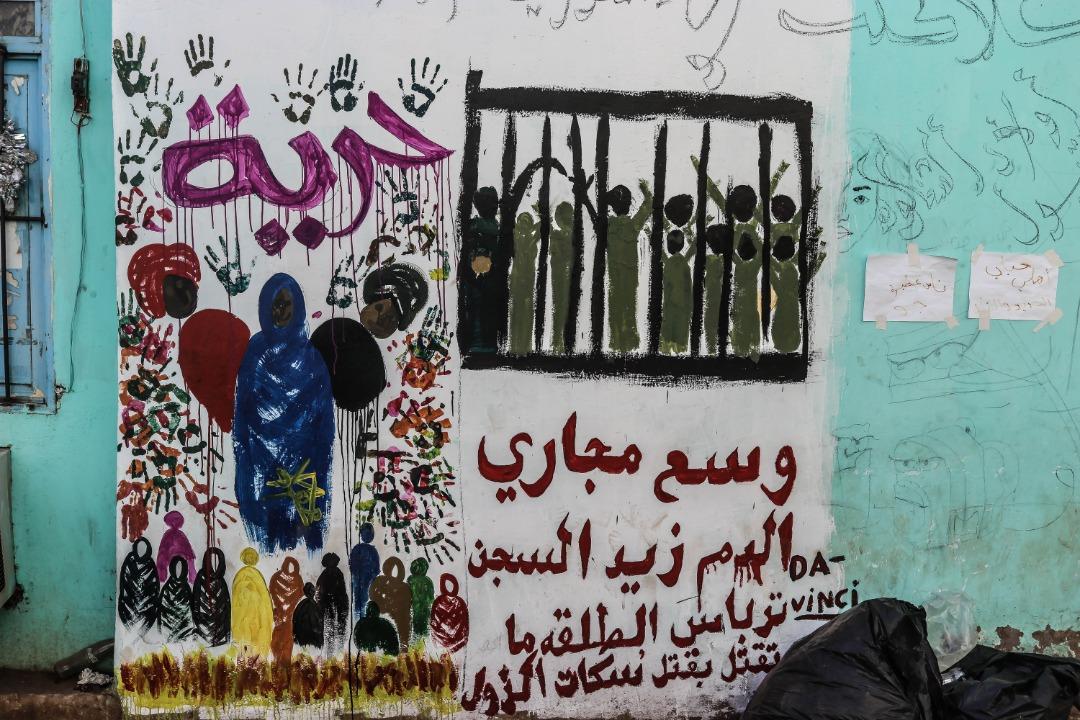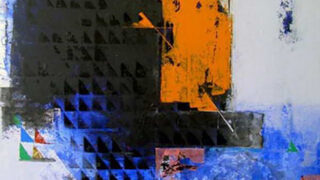
This publication has benefited from the support of the Rosa Luxemburg Foundation. This text may be reproduced in part or in full, provided the source is acknowledged.
The December 2018 revolution crystallized a new frontier for political songs in Sudan, bringing about a shift from the “traditional” contexts and contents, with their standardized and direct language, to a phase of a more “popular” nature, with content drawn from the folkloric Sudanese cultural and linguistic pluralism, and from the lexemes of the marginalized classes of society. The songs which emerged were inspired by the terminologies of the “Rendok”, one of the most popular youth languages in circulation in Sudan, while the musical forms and genres reflected the mood of the revolution’s generation and its aspirations for change. Music and song expressed these discourses through the employment of various world musical genres, such as rap and reggae, and local ones, such as “Mardoum”, “Tum Tum”, and “Jarari”.
Song lyrics reflect the lingual richness of the Sudanese societies and the abundance of its regional tongues and dialects. Khaled Abbas, a Sudanese poet, describes the lyrical poetics of the "December Revolution" as a “carnival of transparency” that reflected a wholesome image of the profuse Sudanese diversity. Words and phrases were breeding in between chants, poems and songs, according to Abbas, who considers that the texts and audios produced during the revolution were successful in crystallizing the cultural and social pluralism in the country with a harmony characterized by the heavily present discourses of the Sudanese margins. The creative methods which coupled the traditional and contemporary means, were able to take advantage of the mass media in order to proliferate, and thus succeed in satisfying Sudan's historical need for further openness to “the other” inside the country.

According to the poet Khaled Abbas, the spread of the “Randok” language during the December Revolution and its use in the political statements of the Sudanese Professionals Association, the backbone of the revolution’s leadership, was an effective paradigm shift that expressed the early bias of the political activists towards the voices of marginalized and excluded societies. The “Randok” became synonymous with rebellion against the old regime and its traditions of communication, in terms of the language and patterns used by the “elitist” political establishment. This brought to the foreground several other linguistic forms that constitute a plural semantic body in Sudan, thus replenishing the vocabularies of poetry and song during the months of the uprising.
“Live Bullet”, a song by Sudanese rapper, Ayman Mao, has become the most popular song in the revolution. While he had launched the song abroad, in this video, he is filmed performing it in Khartoum.
The revolution’s streets as art exhibition spaces
The December Revolution saw the emergence of various forms of plastic art. Much of it comprised independent artworks by individuals, revolutionary groups, and members of the “resistance committees”, created as part of the efforts to mobilize and promote the cause, in addition to the collective, more systematic contributions of amateur and professional artists. Consequently, an artistic movement unfolded in every direction, on both practical and theoretical levels, during the revolution. It continues to expand and push the frontiers of experimentation in the practices of plastic arts.
Artist Abdel Majid Afifi, member of the Sudanese Plastic Artists Rally and member of the Field Committee of the Sudanese Professionals Association, explains that the artworks produced during the revolution started out as tools to promote and advocate the uprising in an artistic contribution to mobilize citizens. They did so in the form of rather uncomplicated murals and slogans made with paint and spray cans – to mitigate the high risk involved in carrying out those art works in public amid an extremely tight security grip. Afifi goes on to explain that the security forces used to wipe clean the murals or cover them up with white paint during the day; however, the artists (individuals and resistance committees) would always come back at night to repaint and rewrite their works. “This process of erasure and recreating has established in itself a new artistic process in which several layers materialized on the canvas (in this case, the walls). Those layers could be read as a visual and aesthetic expression of the chronicles of the revolution,” Afifi argues.
He adds that the day of April 6, 2019, was a turning point in the art scene, as the masses of the December Revolution marched to the Sudanese Army’s headquarters in the heart of the capital, Khartoum, announcing the beginning of the “General Command sit-in.” During this period, the Sudanese Plastic Artists Association, a branch of the Sudanese Professionals Association, launched a campaign to paint on the walls in the vicinity of the army headquarters and its adjacent units. Taking part in the initiative were revolutionaries who hadn’t gone to art school, but who nevertheless possessed enormous expressive capabilities that contributed to enriching the drawing, painting and mural works techniques, resulting in a highly expressive artistic trend, whose nature strays further from the direct propagandist modes.
Afifi points out that the color schemes used were more vibrant, innovative and joyful, inspiring emotions of victory and the desire for life. As for the motifs, he notes a departure from form and the recurrent use of the visual vocabulary of the victory sign, trees, Sudanese women, and patterns that reflected cultural diversity. Afifi also notes that the children's drawings at the sit-in were more focused on four-by-four military cars; the TOYOTAs, also known as “Touchers” in Sudan, and military machine guns. He said, "It is an interesting observation, as these elements were recurrent in the paintings of many of the children who took part in the artistic campaign near the army’s headquarters, many of whom were homeless children.” Afifi attributes this second wave of plastic artwork during the revolution to the sense of victory that washed over the people, as it did the artists and individuals who had created these depictions of victorious times. This was especially evident after the overthrowing of President Bashir's regime, and that of his successor General Ibn Auf as well, successively, in less than a day’s time. That was when the purpose of the art works diverted from incitement and propaganda to the purer free aesthetic expression.
The 6th of April 2019 was a turning point in the art scene, as the masses of the December Revolution marched to the Sudanese Army’s headquarters in the heart of Khartoum, announcing the beginning of the “General Command sit-in.” During this period, the Sudanese Plastic Artists Association, a branch of the Sudanese Professionals Association, launched a campaign to paint on the walls in the vicinity of the army headquarters and its adjacent units.
According to Afifi, the third transformation came after the massacre of June 3, 2019, the day of the dispersal of the General Command sit-in. The artworks afterwards took on a dark undertone, evidently expressed through the harsh brush strokes on the walls and the color palettes used. Bright and joyful tints gradually diminished and were replaced by bolder, somber colors that signified violence, martyrs and rape crimes that had happened. There was more fury than sorrow in the new palettes, and murals expressed angry artistic stances. Works which addressed the cases of the missing individuals after the massacre at the sit-in can particularly be considered a milestone in the artistic practices at the time of the revolution.
On women’s representation and art in the revolution
Afifi concludes that the plastic art works of the December revolution rely on an historical fact that Sudanese culture has a legacy of ancient and extensive mural painting. Nevertheless, the tradition lapsed after the spread of the colonial art education, which founded the “School of Design”, considered to be the educational core of the College of Fine Arts in Sudan. With the standardized wooden easel, painting and artwork became a monopoly among limited groups in society, unlike in ancient Sudan, where drawings, sculptures and paintings on the walls could be found in the temples of the ancient Nubian civilizations, and in the churches of the ancient Christian civilizations in northern Sudan.
When the December Revolution came, it reclaimed this legacy artistically and aesthetically and built on it, bypassing contemporary prevailing trends, including the question of painting in Sudan as an elitist practice, and that of the art exhibition as an elite venue. The revolution reintroduced the art work back into public spaces, streets and walls, opening them up for communal expressions and aesthetics. Afifi emphasized that a number of intellectual, political and philosophical Sudanese figures have called for bringing art to the public during the revolution, not just at the level of the audience/recipient, but as part of the creative process and exhibition. Therefore, and according to Afifi, the December Revolution has created a new and ongoing artistic movement in Sudan, capable of developing and expanding to various new horizons.
The third transformation came after the massacre of June 3, 2019, as the art works took on a dark nature, evidently expressed through the harsh brush strokes on the walls and the surfacing color palettes. The bright and joyful color themes gradually diminished and were replaced by sharp and aggressive colors that signified the violence, martyrs and rape crimes.
Photographer Jihan el-Taher notes a significant shift in the way women have come to be perceived during the revolution, especially in media representations. Based on revolutionary grounds, there was a rupture with the stereotypical mainstream notions on women. Since the media is inseparable from the realities it covers, women became the primary “representatives” of women themselves. Thus, a vast array of representations was produced, each based on the diversity and pluralism of Sudanese communities, and at odds with the conservative and reactionary mentalities. New comprehensive discourses emerged from the fact that Sudanese women were equal partners – and perhaps even more involved than men – in the making of the revolution and leading it in every phase. Women’s omnipresence naturally conflicted with the deep-rooted social, cultural, and religious values in fundamental and complex ways. “Despite the thorny road, the women of Sudan have been able to overcome all obstacles, and we will surely carry on,” el-Taher said.

Cinema and public initiatives
Sudanese cinema was able to meet several artistic milestones during the December Revolution, after decades of the systematic destruction of the infrastructures of filmmaking and film production in the country. In 1989, the state-run Sudan Film Corporation, which was in charge of importing and distributing films to theaters, was dissolved, and in 1990, the Ministry of Culture’s cinema production department was terminated. Afterwards, movie theaters and screening venues shut down en masse. Meanwhile, cuts were made in the budget of the itinerant cinema administration, whose task was to show simple educational films in rural areas. This meant depriving the nomadic and rural communities from being informed on health and development issues.
Sudanese culture has a legacy of painting, sculpting and making wall murals in the temples of the ancient Nubian civilizations, and in the churches of the ancient Christian civilizations in northern Sudan. The December Revolution was able to reclaim this legacy artistically and aesthetically and to build on it, bypassing contemporary prevailing trends and overcoming the question of painting as an elitist practice in Sudan.
“Movies on the Street”, an initiative launched by poet and activist Lamiaa Nabil, was one of the most prominent cinematic revivals during the revolution. Nabil organized periodic film screenings followed by discussions in the public squares and open forums in the streets of the Sudanese capital, Khartoum. Nabil says that although the street had always been a “dangerous place” for young people – and for girls in particular, throughout the years of al-Bashir’s regime, the December Revolution was somehow able to turn it into a safe space, particularly after the success of the sit-in at the General Command. The initiative acted as a “popular civil occupation” of the street, aiming to redefine its purpose and reclaim it from political Islam back to the people. It approached the street as a place that can host the sanctification of public rights and freedoms, including the right to dignified standards for the life for which the youth revolted, and for which the martyrs gave their own lives.

Nabil notes that the discussions on art and aesthetics that took place after the first few screenings at the square revealed the audience’s conscious engagement with serious cinema. The collective taste seemed to have departed from commercial films of Hollywood and Bollywood productions, and towards more refined options. Many viewers suggested some pioneering art films, so the “Films on the Street” initiative handpicked pictures that expressed a vast range of aesthetics from all over the globe, including German, Ethiopian, and Indian cinema. Lamiaa Nabil believes that the initiative was thus successful in conveying an important message to film distributors in Sudan, stressing the need to respect the Sudanese film viewers who seek sophistication and value that goes beyond the cheap Egyptian “El-Sobki Production" films, given that the Sudanese have a passionate appreciation for the seventh art, despite the state's wars against it.
The “Films on the Street” initiative, born during the December Revolution, was the antithesis of decades of a systematic destruction of cinema’s infrastructure in Sudan. In 1989, the state-run Sudan Film Corporation, which was in charge of importing and distributing films to theaters, was dissolved, and in 1990, the Ministry of Culture’s cinema production department was terminated.
In the context of culturally and aesthetically redefining public space, a new phenomenon began to materialize in Khartoum, in which young women would invest in or found new cultural or creative institutions of their own. The young engineer, Maysoon Matar, opened the Fandora workshop which worked on recycling material into useful art works and handicrafts. Sanaa Abu Qasisa, on the other hand, owns and runs al-Musawwirat publishing house, while Lina Hajjar owns and manages Dabanga Art Gallery.
Years before the December 2018 Revolution, three Sudanese young women – who later took part in the revolution - founded the Atelier Johannamiyah in Khartoum Bahri. Café Maril, a cultural meeting space, among several other cultural institutions in Khartoum, was also founded by women, indicating a break with the stereotypical image of the Sudanese women as mere partners or minor contributors in the field of cultural investment and artistic institutions. The women of the December Revolution were called “Kandake” after their ancestral Noubian queens in Sudanese history. Those of them who worked in managing cultural and creative programs were the “Kandakes” of the streets, occupying the public spaces, mingling with people from various backgrounds and popular or underprivileged regions, and listening to what those people especially had to say and create.
The manager and owner of Maril cultural café in Khartoum, Tasabih al-Amin, explains that the idea for her project was born during the revolution. Through her personal efforts, friends’ support, encouragement from people, and self-financing, al-Amin was able to cover the expenses. She even had to sell her mobile phone to make it happen, but finally, the café was opened as a cultural forum that contributed to showcasing art, promoting cultural projects and raising awareness. It was a place where open discussions and meetings were held, in a meaningful, serious manner, distinct from the way most venues worked in Khartoum.
The goal was to bring about a conceptual and cultural change among the youth, by holding seminars, discussions and candid meetings for public attendance, in an open atmosphere which sets no red lines in dialogue. Al-Amin explains that under the previous regime, cultural policies meant that every activity was planned in such a way as to lead to the predetermined conclusions and outcomes, as set by the government, whereas the Maril project, on the contrary, sought to open up serious discussions about the social realities and make room for the questions and concerns of those who were born after 1990. She adds that Café Maril offers a public venue which is always interested in hosting intergenerational dialogues, in a central location in the capital city, Khartoum, and from one of its most popular neighborhoods inhabited by poor and marginalized citizens.
According to al-Amin, Maril’s visitors are not exclusively the revolutionary intellectuals and young members of the resistance committees; they are also police officers, tea ladies (women who sell tea on the streets), and other workers, who found in the café a space where they could redefine themselves and their relations to other components in Sudanese society in the context of the newly-found spaces and ways for interaction within the revolution. The main feature of this venue is its contribution to this bridging between social groups and to the shaping of a popular dialogue in the context of the social conflict in Sudan. Tasabih al-Amin notes that during the Inqaz regime’s rule (al-Bashir’s regime), forums and cultural venues- even those that were considered “democratic”- were made up of elitist gatherings of an exclusive group of upper-class intellectuals, held in prestigious locations that only the privileged owners of private transport vehicles could visit. In al-Amin’s opinion, those spaces did no more than reproduce the epistemological and class disparities between the social components, and thus contribute to preserving the inherent privileges of the upper class.
New comprehensive discourses emerged from the fact that Sudanese women were equal partners – and perhaps even more involved than men – in the making of the revolution and leading it in every phase along the way. Women’s omnipresence naturally conflicted with the deep-rooted social, cultural, and religious values in society.
Al-Amin recalls struggling a lot with several patriarchal authorities, everywhere from her home to society outside, when she was starting her project. The prevalent assumption was that a woman had specific roles to play, and that a university graduate like herself had a different task to fulfill. Her own father showed some concern about the idea of the café and considered it risky. However, al-Amin believes that the revolution’s “Kandakes” were destined not only to stand in the face of bullets, arrests, and imprisonment, but also to fight for the projects they believed in, like Café Maril which strives to be a window that oversees a different horizon.

Public discussions: The body as an asset and a right
The doors to bold discussions on personal rights were kicked wide open with the December Revolution, especially those debates pertaining to autonomy over the body. The most explosive of which happened in January 2019, and tackled the incident of some students of “Ahfad University for Women” in Omdurman raising their middle fingers against the government in the midst of a revolutionary procession. The women were trapped by police and security forces inside the university campus at the time, and social media accounts affiliated with al-Bashir's government considered the incident a violation of the acceptable social norms and manners. Meanwhile, human rights advocacy groups embarked on localizing this body gesture, contextualizing it within the semiology of the body and its expressive language, and in its relation to the rebellious revolutionary discourses which reject all organizational systems, and thus dissociating it from the negative moral, cultural, and gendered connotations. Furthermore, Sudanese researcher Nahla Mahmoud, who resides in the United Kingdom, also sparked wide controversy in March 2019 when she posted a status on her personal Facebook page about her relationship with her own body hair. Feminists and human rights activists engaged in the discussion about freedoms, culture, women’s autonomy over their own bodies, beauty standards, cultural preferences, and the many layers intertwining in these subjects.

An even fiercer controversy revolved around the question of sexual rights and orientation, after Sudanese artist Ahmed Umar, a gay man living in Norway, took part in the solidarity rallies for the Sudanese revolution in February 2019, clad in Sudan’s flag. While many supported the right to express all sexual orientations and considered this to be an integral part of the revolutionary act for the Sudanese inside the country and those abroad, others opposed this idea based on religious or local traditional discourses.

Shaza Balla, a US-based Sudanese writer, researcher, and political activist, concludes that the December Revolution was, in fact, an amalgam of several revolutions on all kinds of levels, one of which was primarily concerned with refuting the ideological frameworks surrounding “the body”, regardless of its gender. Both men’s and women’s bodies have always been policed in the context of the grand ideological project of the former regime that encouraged growing beards, imposed headcovers on women, and limited the acceptable physical attires of citizens. In the name of “public order”, men’s heads were forcibly shaved, and women were arrested for violation of the established dress codes.
Balla continues that the revolution had culminated in the sit-in at the General Command, where one could study a panoramic image of the different beliefs and the nonhomogeneous political, social, and individual trends and movements filling the streets, in a popular celebration that went on for months. Although, the researcher notes that with regard to questions on the body, progress may seem slow, as the issue addresses the collective consciousness of societies just emerging from a thirty-year-long repression. However, she stresses the importance of engaging in such conversations today and the necessity of speaking about the body, feminism and personal rights, so that the established acceptable standards are dislodged. In Balla’s opinion, the emergence of such conversations related to the body, whose image has always been axiomatic, in the forefront of public debates is one of the greatest achievements brought about by the revolution. She asserts that the dialogue will certainly continue, and with it several battles are bound to be won or lost, but what’s important about this process is the fact that the monolithic notions are certainly bound to break. The democratic transition that celebrates diversity must then include bodily expression and representation, and it is essential that a legal framework is devised to protect these rights and reassess the meaning of values according to human right charters.
The Department of Justice of the transitional government has been working on freeing the body from the bottleneck of ideologies, and partial success was achieved with the amendment of the Sudanese Criminal Code for the year 2020. “Legal reform will allow latent revolutions to erupt and reshape not only the body image, but the entire cultural and moral structure of the Sudanese society,” Balla concludes.
Extensive discussions were launched on freedoms, culture, women’s autonomy over their own bodies, beauty standards, cultural preferences, and the many layers intertwining in these subjects, and an even fiercer controversy revolved around the question of sexual rights, orientation, and personal choice.
For sociologist Rasha Abdel Hafeez, despite significant progress in some issues, it might be too early to talk about a major social change at the level of vulnerable groups in Sudanese society, as most changes currently underway in Sudan are part of the transitional period and, therefore, superficial. They are mere alterations in the shallow waters of politics, and fall short of the fundamental change capable of disrupting the old social structures and the prevalent reactionary ideologies. Indeed, here lies the primary challenge facing the youth of the revolution and the Resistance Committees – the two groups whose voices were loudest in representing Sudan’s revolutionary streets. Any real and radical change that reflects their aspirations, demands for change, and struggles for human rights must, henceforth, be incorporated in an imperative long-term process that transcends immediate topical change in Sudan.
• Photographs are used with the permission of the Sudanese Professionals Association and the Sudanese Plastic Artists Rally (SPAR).
The content of this publication is the sole responsibility of Assafir Al-Arabi and Rosa Luxemburg Foundation cannot accept any liability for it.
Translated from Arabic by Sabah Jalloul
Published in Assafir Al-Arabi on 24/12/2020




